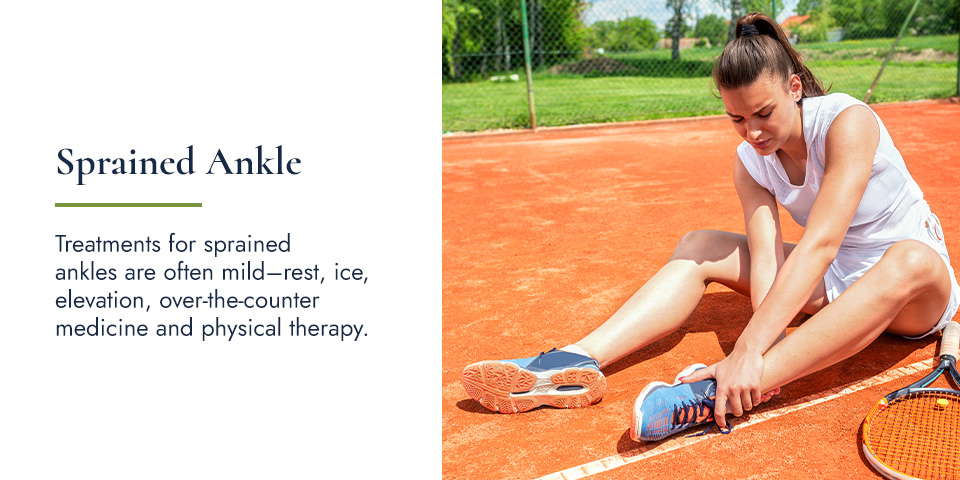
While it’s a relatively safe, no-contact sport, there are some risks in tennis. Playing your best game means taking some steps to prevent common tennis injuries. While the game is fun, tennis-related aches and pains aren’t — to help you feel your best on and off the court, here are some common injuries and some tips for preventing them.
Tennis elbow, or lateral epicondylitis, is a type of tendonitis that develops when a person overuses the tendons in their elbow. Repetitive motions of the wrist and arm can cause the injury. When someone overuses the tendons, the tendons slowly begin to pull away from the bone, causing microscopic tears.
A person suffering from tennis elbow may have the following symptoms:
Tennis elbow is usually treated by icing the injury, taking anti-inflammatory medicine. If the pain is persistent, they may need a steroid injection or surgery.
Rotator cuff tears occur in tennis players progressively as the tendons are damaged from repetitive use. The motions in tennis put a lot of strain on the shoulder muscles, causing the tendons to tear over time.
The serve is the most energy-demanding move in the sport. Accounting for 45%-60% of all strokes in the game, the motion puts a high amount of strain on the shoulder, sometimes resulting in a torn rotator cuff. Rotator cuff injuries vary in severity — it can be either a partial or complete tear.
Symptoms of a rotator cuff tear include:
Treatments for the condition include taking a break from strenuous activities, icing the shoulder, taking anti-inflammatory drugs, receiving steroid injections and enrolling in physical therapy.
Wrist injuries are common among tennis players — these injuries can occur progressively or from a single traumatic event. The pain associated with the injury often results from damage to bones, ligaments, tendons and nerves.
Tendon injuries are the most common. Wrist pain is often identified by its location. If the pain is on the thumb side, it is radial, and if the pain is on the pinkie side, it is ulnar. Wrist pain on the ulnar side is the most common among players.
Symptoms of wrist injuries can include:
Once the cause of the pain is found, treatments for wrist injuries often involve modified activity, wrist stints, ice, anti-inflammatory medications or even steroid injections.
Jumper’s knee, a condition called patellar tendonitis, occurs when a person overuses their knee joint, such as frequently jumping on a hard surface. It is one of the most common tennis knee injuries.
When an activity puts too much stress on the patellar or quadriceps tendon, the tendon becomes inflamed or torn.
Symptoms of jumper’s knee include:
Treating jumper’s knee often involves rest, knee elevation, ice and strengthening exercises.
Ankle sprains are one of the most common reasons people in sports miss practices and games. When the ligaments that support the ankle stretch past their limits and tear, the result is a sprained ankle. The seriousness of the sprain is determined by the amount of ligaments involved in the injury and how badly they are torn.
People often sprain their ankles when they accidentally twist their feet. This injury is especially common in tennis due to the amount of jumping and quick motions involved.
Symptoms of a sprained ankle include:
Treatments for sprained ankles are often mild–rest, ice, elevation, over-the-counter medicine and physical therapy. If these treatments do not work, surgery may be needed.

A stress fracture occurs when a person performs repetitive movements and refers to a weak point in a person’s bone structure where the bone tissue breaks down faster than the body can repair it. It is estimated that 5%-8% of the population will develop this injury, particularly youth athletes.
Tennis players are especially prone to developing a stress fracture in their back due to constantly bending backward and forward and rotating their spine.
If a player has a stress fracture in their back, they may develop the following symptoms:
When a doctor discovers a stress fracture through an X-ray, the player should not participate in the sport that caused the injury until they are fully healed.
Although each injury is unique, there are common steps you can take to help prevent them. These steps range from specific exercises to prevent tennis injuries to buying the right game equipment.
These are the best practices to follow to stay safe and healthy during every game:

Located in Harrisburg, Pennsylvania, the Colonial Golf and Tennis Club is a beautiful facility where you can play a leisurely or competitive game of tennis.
If you are a new player and want to learn the basics of the game before hopping on the court, we have a tennis pro who gives private lessons. Our instructor, Maja Palaversic, went pro at 15 and competed in all four slams. She is certified and has been coaching since 1999. With her knowledge, you can learn the game while preventing common injuries.
To book a private lesson or become a member, call us at 717-657-3212 or complete our online form.